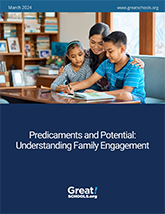Predicaments and Potential: Understanding Family Engagement
A report tracing the evolution of family engagement in K-12 education, including key data and offering insights for the future.
There’s long been a gap between families from disadvantaged backgrounds and their children’s schools. Not only are their children more likely to experience inequitable treatment and less access to resources, but they are more likely to face unfair disciplinary measures and attend schools where few teachers share their lived experiences. Between the pandemic and our country’s reckoning with its history of racial injustice ignited by the Black Lives Matter movement, the distance between public schools and families has only grown. Enrollment, especially in disadvantaged communities, has dropped in many districts, as have attendance rates. Microschools abound; homeschooling has exploded. The mysterious phenomena of “missing children” – students no longer enrolled in any school, including private schools or homeschooling – has spawned extensive reporting but few answers. Educators have reported widespread disengagement and an uptick in behavior problems by students – especially those from disadvantaged communities, which may have contributed to the rise in teacher burnout and turnover. Faced with mounting evidence that engaging families is becoming more difficult than ever, the need to better understand the experiences and concerns of these families, including how best to communicate with them, serve them, and ultimately learn from them, is more essential than ever. Ultimately it’s the districts and schools that discover the best strategies for reaching and understanding disengaged families that will not only solve their institutional problems of attendance and enrollment, but evolve our education system to reflect the needs and wants of the people they serve.
In this report, we will trace the evolution of family engagement in K-12 education from its origins as an idea to a full-fledged profession with ever-expanding roles and responsibilities. We will also explore the lessons and limitations of the field, identifying best practices gathered from research and practice. Finally, we will share insights from internal GreatSchools research drawn from our platform that reaches nearly half of all K-12 households each year. Here we will focus on what families furthest from opportunity (including low-income, Black, brown, and Indigenous families) prioritize and are experiencing in their children’s educational journeys, drawing on focus groups, user behavior on our site, surveys, and one-on-one conversations. We will conclude with recommendations for the field on how to best reach these families and continue learning from the schools and districts that are listening to parents and adapting their policies, practices, and programs to best serve them.
For more information about this report, contact research@greatschools.org.
